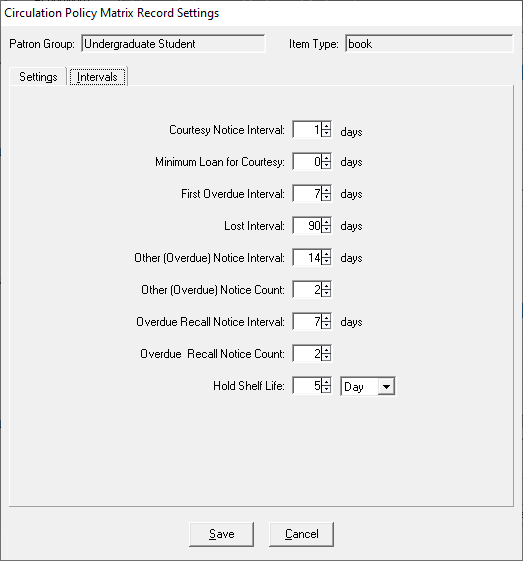Circulation intervals in Voyager and when notices are produced
- Product: Voyager
- Relevant for Installation Type: Multi-Tenant Direct, Dedicated-Direct, Local, TotalCare
Question
How do overdue notice intervals work?
Answer
Intervals are the amount of time that should elapse before certain events occur.
They are set in: SysAdmin>Circulation>Policy Definitions>Matrix>Item/patron group entry (or all)>Modify>Intervals>
For example, the Lost Interval defines how long an item is overdue before it is deemed a lost item.
The Courtesy Notice Interval is the number of days before an item is due when a courtesy notice can be produced, if you choose to send Courtesy Notices. A courtesy notice is sent only once unless the item has been renewed.
The First Overdue Interval is the number of days after an item becomes overdue that pass before producing the first overdue notice.
The Other Interval is the number of days to pass before producing each subsequent overdue notice.
Voyager only sets notice intervals in days. There are no options available to set notice intervals for hours or minutes.
Example Intervals Tab:

Example Scenarios:
Let say on your Intervals tab that the First Overdue Interval is 3 days.
The item was due 8/10. So the first overdue notice will be generated when the item is 3 days overdue -- so after the calendar's close of business on 8/13.
When the jobs run overnight, they add this notice to the file to be processed, and the notice is produced when the file is processed on 8/14.
Similarly if an item has a 7 day First Overdue interval and was due on 8/6, those notices would be processed and then produced on 8/14 as well.
Additional Information
See the System Administration User's Guide.
Support recommends you run your batch jobs daily, and run Reporter to build/process the reports and notices each day the Library is open.
- Article last edited: 08-10-2021

